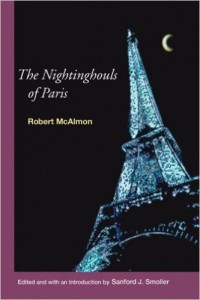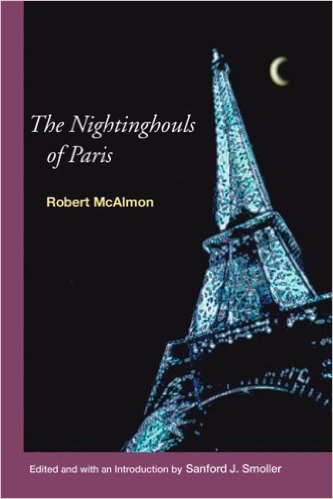 The Nightinghouls of Paris
The Nightinghouls of Paris
by Robert McAlmon; edited by Sanford J. Smoller
University of Illinois Press
264 pages, $40.
ROBERT MCALMON. The name may seem familiar, but probably as an adjunct to some other writer. Born in 1895, as a teen he may have been in love with Gore Vidal’s father, as Vidal infers from McAlmon’s later novel Village. In 1921, although gay or bisexual himself, he accepted a marriage proposal from H.D.’s lover Bryher, an arrangement that got her family off her back and got him a solid income. In Paris in 1923, he used money from Bryher’s family to establish the Contact Publishing Company, which published modernist works by Djuna Barnes, Gertrude Stein, William Carlos Williams, and Nathanael West. He went to the bullfights with Hemingway, he published Hemingway, he gossiped about Hemingway, he got punched out by Hemingway. And because he knew everyone in Paris, he turns up in the memoirs of many of the American expatriate writers of the time.
He even became a supporting player in his own most widely read work, his 1938 memoir Being Geniuses Together, with its crisp descriptions of the literary figures he knew in London and Paris: Hemingway, Stein, T. S. Eliot, James Joyce, Ezra Pound, Ronald Firbank. Unfortunately, the memoir is best known in its 1968 version, which the writer Kay Boyle “revised” after McAlmon’s death in 1956, cutting some of his material and interleaving her own autobiographical chapters, which are full of self-absorbed, overwritten prose. The geniuses who were “together” in the book’s title now seemed to be Boyle and McAlmon (who were never together in any meaningful sense), instead of McAlmon and the true geniuses he had written about.
But McAlmon was more than just a friend of or husband of or publisher of other writers. He’s a writer who demands attention in his own right—not a major writer, perhaps, but one whose personality comes through so strongly that you befriend him from the first paragraph, much the way you do with Frank O’Hara. This at least was my experience with The Nightinghouls of Paris, a previously unpublished memoir of late 1920’s Paris that McAlmon biographer Sanford Smoller found in the Yale library. After a couple of chapters, I went out and grabbed every McAlmon book I could find. I wanted to know this man.
Smoller’s long introduction gives abundant context for the memoir and, in a sweetly partisan way, defends McAlmon: against Hemingway, against Fitzgerald, against Kay Boyle, against John Glassco (more on him later), against literary critics, against oblivion. Smoller also provides extensive notes and, best of all, a key for decoding this memoir à clef, where the names are changed but the characters shine through: Hemingway, Djuna Barnes, Ford Madox Ford, Peggy Guggenheim, Kay Boyle, and Louise Bryant, among others.
This memoir is not, however, another celebration of the geniuses of Paris. That Paris, with all its intoxicating creativity, was yesterday. What was left is suggested by the memoir’s awful title (McAlmon’s own, and the worst thing in the book), a word suggesting that the current denizens of Paris are the walking wounded. Women enmeshed in pointlessly complicated romances, men posturing as great writers, the only activity a ceaseless restlessness, the only intoxication coming from the shocking amounts of alcohol consumed—this is the Paris of the nightinghouls.
Yet the memoir itself is not depressing. McAlmon’s writing gives too much pleasure for that. He has a gift for concise verbal portraits, summing up a character in a couple of (frequently devastating) sentences. He is aware of human frailty but unforgiving of self-inflicted wounds, non-moralistic in his personal judgments but severe in his literary ones. His constant intellectual vitality shrinks from the enervation it describes, even as he himself sinks into the general ennui that finds in Paris “really another city of hometown souls perplexed by village woes.”
To point up what the famous have become, McAlmon turns to the non-famous of Paris. On the first page, he runs into Hilaria, a young Montparnasse demimondaine who appears throughout the book, so that her uncomplicated attitude toward love can stand in contrast to that of her more famous sisters. As she tells McAlmon, “There are always the beautiful men, and for me who feels strong character like a man, I let them do the suffering. It is nothing in the life to make grand things out of love.” Then, to prove her point, a few pages later we meet “Steve” (Thelma Wood), over whom Djuna Barnes (here named “Chloe Andrews”) indeed makes “grand things”: “Steve was a handsome girl-boy, with a boy’s predatory curiosity, sentimental and unaware of conscience. … [Steve] found it trying to cope with Chloe’s starved-mother idealizings. Under a hard-boiled mask Chloe so idealized whomever she loved that others than the susceptible Steve believed her incapable of wanting the ‘truth’ she spoke of, however it was presented.”
Another woman given to complicating her life is Louise Bryant (here “Rose Morgan”), the journalist whose marriage to John Reed is the subject of the film Reds: “Once, by following where her Communist husband led, she had a name and reputation as a dramatic and adventurous person. She participated in labor fights, went to jail, and was pleased at the attention and flattery of men who often stood for everything she thought she resented.” Again, McAlmon provides a contrasting voice, giving the last word to a “world-worn, world-knowing” patronne at the bar where Rose is getting drunk: “Madame is perplexed about situations in her life. … She will always suffer emotions about the same kind of thing, never learning by experience, never knowing that ennui and resignation have their satisfactions.”
As for the writers he meets, McAlmon is not impressed. In noting how Hemingway, Ford Madox Ford, and other writers are congregating in Paris, he says: “Among so many writers, one might pursue the phantom—intellect—but encounter mere shop talk and the diplomacies of writers pretending to be awed by the others’ success.” He is repelled by the postures that Hemingway (here “Forrest Pemberton”) puts on: “When Pemberton shadow-boxed, shadow-bullfought, or cauterized scratches with a burning match to prove his stoicism before pain, his self-hardening process left me embarrassed.”
Hemingway also figures in a magnificent scene with Duff Twysden (“Lady Mart”), the model for Brett Ashley in The Sun Also Rises, now broke, drunk, and desperate: “She appeared to bother little about mere cleanliness now. Her breath, her whole being, emitted an odor of stale cognac. She drank not to forget or become hilarious, but to break down what feeble reserves she had so that she might weep because of her panicky desperation. Perhaps she drank hoping that soon drink would kill her, but perhaps she had not even calculated that.” She has a painful encounter with Hemingway (“Pemberton”) and his new wife, and gets a thousand francs from him. McAlmon sums up the situation thus: “He had claimed to love her, and the story of his romance had made thousands of American college boys’ hearts quiver. … On Mart’s side, she would be pointed out to tourists and romantic young men as the heroine of his book.” In fact, as the chapter ends, “Mart was deep in conversation with three college boys from America. One was thrilled to discover that she was the original of Pemberton’s frail heroine. Mart was being gay, feeling capable of making more conquests, and what do boys come to Paris for if not to have romance?”
To keep the memoir from being just a series of such anecdotes, McAlmon includes a unifying narrative centered on two young Canadians, John Glassco (“Sudge Galbraith”) and Graeme Taylor (“Ross Campion”). These two don’t merit a mention in Geniuses—Boyle slipped one paragraph about them into one of McAlmon’s chapters—but McAlmon has chosen to make them central to Nightinghouls. Glassco would much later become a poet, but here he is a newly arrived eighteen-year-old, traveling with the slightly older Taylor, both in Paris to become writers. McAlmon points up the symbolic contrast between his jaded generation and the hopefulness of the boys: “I had misgivings about my lost generation, which is thwartedly illusioned and in revolt to such an extent as to be incapable of detachment. … Were the boys of the new generation free of the sentimental complexities that once bothered us?”
Yes and no, as it turns out. The boys have bright ideas about writing, and they see through the pretensions of the older writers: Sudge wickedly says of Hemingway, “I’ll bet he’s written a war book in which he just won’t tell the world how much he really suffered.” As for love, Sudge and Ross are devoted to each other: “Never in years of knowing the Quarter had I seen so fine an example of schoolboy love and accord.” They aren’t exactly gay, though people assume they are, and when Sudge has affairs with women, Ross mopes in depressed jealousy. (According to Smoller, Glassco and Taylor went to live together until Taylor’s death, often in a ménage à trois with one or the other’s wife.) As the book progresses, their relationship becomes as painful and complex as any other in the memoir, and their dreams of writing fritter away in dissipation. In this way, they recapitulate the decline that McAlmon sees in Paris as a whole, from the geniuses to the nightinghouls.






